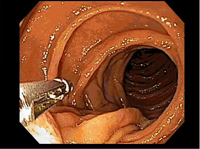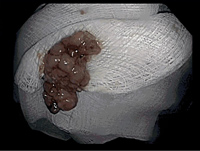BLOG: 86-year-old male with obscure, occult GI bleeding
Haroon Shahid, MD, is currently a third-year Gastroenterology fellow at Thomas Jefferson University Hospital. He is interested in pancreaticobiliary pathology and interventional endoscopy. He will pursue additional training as the Advanced Endoscopy fellow at Thomas Jefferson University Hospital next year.
The patient is an 86-year-old male with a past medical history of hypertension, stroke, atrial fibrillation on anticoagulation who presents to the outpatient office for evaluation of anemia. He denies any dysphagia, odynophagia, GERD, weight loss, abdominal pain, nausea, vomiting, diarrhea, constipation, melena, or hematochezia. He denies any history of overt gastrointestinal bleeding but had been told that he had a positive fecal occult blood test recently. He denies any lightheadedness, headaches, chest pain, or shortness of breath. He denies any history of liver disease.

Haroon Shahid
His past medical history is significant for hypertension, atrial fibrillation, stroke, benign prostatic hypertrophy, sciatica, and anemia. His surgical history is significant for a cholecystectomy, laminectomy, and prostate biopsy. He denies any family history of gastrointestinal malignancies.
His outpatient medication list includes amlodipine, rivaroxaban, tamsulosin, pregabalin, and a multivitamin.
His pertinent physical exam findings include an irregularly, irregular heart rate and a 2/6 systolic murmur. His abdominal exam including a rectal exam was completely normal. His fecal occult blood test was negative during this exam.
His laboratory results show an iron deficiency anemia, with a hemoglobin of 9.4 g/dL. His serum iron, ferritin, and percent iron saturation were low with a normal total iron binding capacity. His B12 and folate levels were also normal.
Prior to being referred to the Gastroenterology Department at Thomas Jefferson University Hospital (TJUH), he was evaluated by another gastroenterologist and had endoscopic evaluation. He had an EGD which demonstrated a small hiatal hernia and mild duodenitis. He had a colonoscopy which showed pan-diverticulosis but no masses or sources of GI bleeding. He also underwent a capsule study which was of poor quality but did show a possible polyp in the jejunum and was therefore referred to TJUH.
He was asked to hold his rivaroxaban and underwent an antegrade single-balloon enteroscopy. During this procedure he was found to have a villous 8 cm mass with stigmata of recent bleeding in the proximal jejunum. This mass was noted to be on a long stalk.



A piece-meal polypectomy was performed using a hot snare in the proximal jejunum. The polyp was completely removed. After removal, there was some bleeding from the remaining stalk. For control of bleeding, the base of the remaining stalk was injected with 5 cc`s of epinephrine (1:10,000) and 2 clips were applied with successful hemostasis
Question: What is your diagnosis?
Answer: Hamartomatous, Peutz-Jeghers Type Polyp
The pathology specimen did show a hamartomatous, Peutz-Jeghers type polyp.
This is an example of a solitary Peutz-Jeghers Polyp (PJP). The incidence of these is not known but there are multiple case reports in the literature. These hamartomatous polyps are usually asymptomatic. If they become symptomatic, they can present with GI bleeding, obstruction or abdominal pain. It is thought to be a distinct entity from Peutz-Jeghers Syndrome.
Peutz-Jeghers Syndrome is a rare, inherited autosomal dominant hamartomatous polyposis syndrome. It is characterized by gastrointestinal hamartomatous polyps and mucocutaneous pigmentation of the perioral buccal mucosa and hands and feet. Peutz-Jeghers Syndrome carries an increased risk of small bowel cancer with the cumulative risk increasing with age. It also carries an increased risk of extra-intestinal malignancies, including pancreatic cancer, ovarian cancer, breast cancer, lung cancer, and cervical cancer. PJPs, on the other hand, are not associated with mucocutaneous pigmentation, are not inherited, and do not carry an increased risk of extra-intestinal malignancies.
Like gastrointestinal polyps in Peutz-Jeghers Syndrome, solitary PJPs do also carry a risk of neoplastic change. This risk is thought to be lower than the risk of neoplastic change in Puetz-Jeghers Syndrome. PJPs can be seen on CT scan (if large), capsule study, or endoscopically. The diagnosis is made histologically. The current recommendation is to remove PJPs endoscopically or surgically.
In conclusion, solitary Puetz-Jeghers type polyps are an uncommon type of polyp in the GI tract. It is important to be familiar with them and their increased risk of malignancy.
References:
Beggs AD, et al. Gut. 2010;59:975–86.
Calva, et al. “Hamartomatous polyposis syndromes.” Surg Clin North Am. 2008;88:779–vii.
Sone Y, et al. Gastrointest Endosc. 2000;51:620-622.
Suzuki S, et al. World J Gastroenterol. 2008;14:944-947.
Sekino Y, et al. J Med Case Rep. 2011;5:240.
